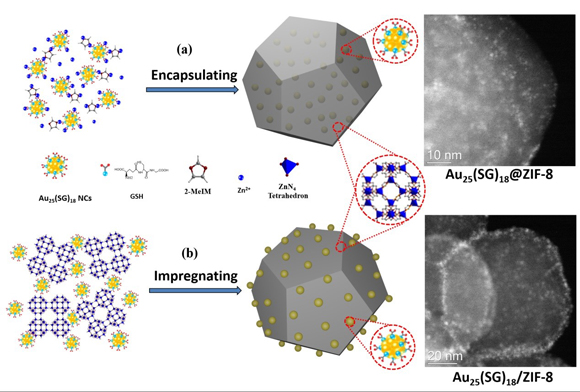Dr. Jianying Shi’s Group at School of Chemistry developed a general strategy to position Au25(SG)18 nanoclusters inside and outside Metal-Organic Framework ZIF-8
Source: School of Chemistry
Written by: School of Chemistry
Edited by: Wang Dongmei
Gold nanoparticle has attracted great interest in the field of catalysis in recent years due to its mild reaction conditions and high selectivity for target products. Different from conventional gold nanoparticle, atomically precise gold nanoclusters (diameter< 2nm, au ncs) protected by thiolate ligands with discrete energy structure possess intriguing size-specific optical, electronic, and catalytic properties. Surface thiolate ligands are indispensable for maintaining the atomically precise structure of Au NCs. However, as a promising heterogeneous catalyst, the accessibility of Au atom surface is essential for reactants in Au NCs catalysis, which requires the removal of the thiol ligand to expose more active sites and reduce steric hindrance. Many efforts have been made to maintain Au NCs structural integrity after stripping of the thiol ligands, e.g., stabilizing Au NCs by strong metal-support interactions and developing mild ligand removal methods.

Metal-organic frameworks (MOFs), featuring desirable pore structure with rationally design, are promising candidates for nanoparticle immobilization. Dr. Jianying Shi’s group developed a general strategy to encapsulate Au25(SG)18 into a ZIF-8 matrix or arrange Au25(SG)18along outer surface of ZIF-8 crystals via the typical Zn-carboxylate type of linkage at the interface. As-prepared nanocomposites retain the high porosity and thermal stability of the ZIF-8 matrix, while also exhibiting the desired catalytic and optical properties derived from the integrated Au25(SG)18 nanoclusters (NCs). In view of the variety of Aun(SR)mNCs with well-established heteroatom doping functionalization to Aun-xMx(SR)m(M = Pd, Pt, Ag, and Cu), and numerous MOFs relied on -COOH or -NH coordination, the synthesis strategy of this work may open up a new way to explore multifunctional MOF-based materials for adsorption, catalysis, bioimaging, and sensors.
Link to the article: http://onlinelibrary.wiley.com/doi/10.1002/adma.201704576/full
